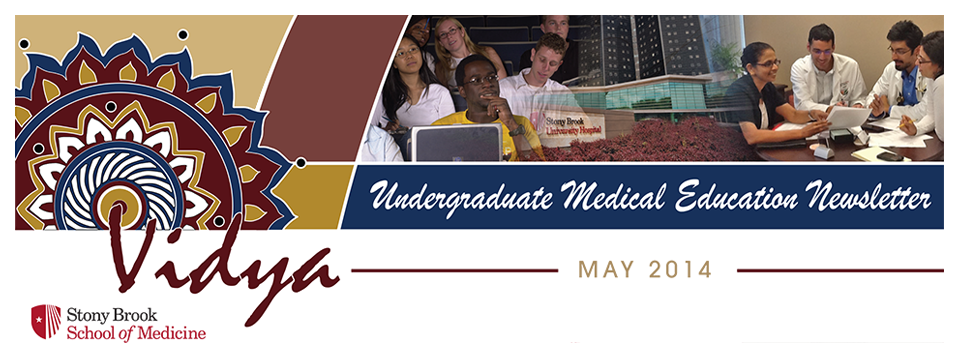| Download PDF Version |
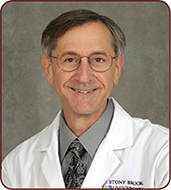
Greetings all. May marks the completion of our 40th year graduating outstanding physicians, and to celebrate our successes, the 2014 School of Medicine Commencement Ceremonies will be particularly special. In anticipation of our 40th graduation, over the past year, we have been filming our students, alumni, and our past and present leaders to produce three short films, to “debut” during Commencement, May 22nd in the Staller Center. Together, the ceremonies will be a Dickinsonian like event, showcasing “Stony Brook School of Medicine Past”, “Stony Brook School of Medicine Present”, and “Stony Brook School of Medicine Yet to Come”… just imagine what life was like in 1974, the year of our first graduation…despite the oil embargo of 1973, the cost of a gallon of gasoline was 53 cents; the median US household income was $11,197 and Richard Nixon resigned the Presidency of the US… all of this in addition to our usual exciting choreography of family, friends, and mentors hooding our graduates, two talks by our graduating students, a number of awards to be announced and 130 new physicians taking the Hippocratic Oath, exchanging the term “student” for “doctor” (although we all know we all remain life-long students of medicine)…and all of this in the setting of the construction of two new buildings, 175 new Stony Brook School of Medicine faculty members, nine new department chairs, four new deans, a new University Hospital senior leadership team, and our ushering in a new curriculum in Fall. I can’t wait!
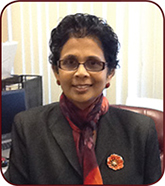
This is a historic moment for the School of Medicine. We are graduating our 40th class this May of 2014. We are a young school, but we have grown up really really fast! Today we have the vitality of youth and the collective energy to move forward expeditiously in all of our mission areas. I remember like yesterday the first day I started as a faculty member in the Department of Pediatrics in July 1992. I had no idea where life would take me, but with the support and mentoring of a wonderful group of colleagues, I was able to blossom, unfettered. I saw our faculty achieve great career success in many venues, but there was always a sense of camaraderie. I believe allowing a person to experience and develop his or her own passion and skills in an environment of challenge and support is an excellent way to bring out the best in people. As I reminisce on my last 11 years’ work in the School of Medicine Dean’s Office, I can honestly say that I have had the fortune to work with many brilliant minds and many outstanding collaborative teams. I have had the fortune to witness transformational changes at Stony Brook. Our students continue to amaze me with their varied backgrounds, unbridled idealism, professionalism as well as their engagement with the school. They serve on every possible committee, facilitate bringing in the next group of exceptional students, and contribute meaningfully to help us become what we are today. We are launching a brand new curriculum this fall semester — all with the help of many eager and willing students. (Please read Dr. Fleit’s write up on the LEARN curriculum). Our students continue to score above the national mean for all standardized tests and for the match rate in the National Residency Matching Program. Our graduates are our ambassadors as they join prestigious training programs across the country. It is heartening to hear what their program directors tell us about them. They are highly professional, communicate and work very well in teams and truly care about their patients…what more would a school want to hear about its graduates? Our alumni stay on in academics more than the national average as well indicating their training and commitment to the pursuit of new knowledge. As we bid this graduating class goodbye, all I have to say is this: We know you will make us proud. Pursue your dreams with passion, in a humanistic and professional way with integrity and resilience. The future that emerges will amaze you as you look back. All the best in this exhilarating journey!
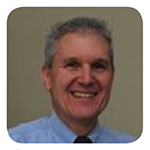
We are delighted to welcome Dr. Richard Iuli as our new full-time Medical Education Specialist. Dr. Iuli earned his Ph.D. in Science Education and Curriculum and Instruction from Cornell University, M.S. in Botany and Plant Pathology from the University of Maine, and B.S. in Natural Resources Conservation from the University of Connecticut. His scholarly expertise is in the area of applied cognitive learning theory with focuses on knowledge capture and representation, metacognition, and the development and assessment of student conceptual understanding of science, all within the context of small-group, collaborative learning environments. Dr. Iuli has taught extensively in the biological sciences at Cornell, Ithaca College, the University of Rochester, and SUNY Empire State College. His work in medical education has included curriculum reform at the Cornell University College of Veterinary Medicine and student academic support at the Medical College of Wisconsin. He has received several teaching and curriculum development awards from Cornell, the University of Rochester, and the Medical College of Wisconsin. Here at SB SOM, Dr. Iuli will be instrumental in many of the implementation aspects of the new LEARN curriculum. Please join me in welcoming him to Stony Brook.
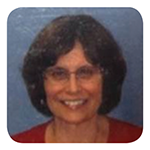 Dr. Marilyn London has been the Assistant Dean for Medical Education since 2002 and Registrar since 2012. She is retiring after having worked at Stony Brook for 20 years — in the School of Medicine since 1996 and, previous to then, in the School of Health Technology and Management. As many in the community know, Dr. London has played a vital role in the smooth functioning of the SOM UGME office and has been instrumental in computerizing many of our office functions. She pioneered the introduction of electronic and customized NBME exams into our assessment systems, as well as electronic transcripts, and has been engaged in the work of innumerable committees and student related functions. In addition, Dr. London has facilitated small groups in the Medicine in Contemporary Society I and II and the Foundations in Medical Practice courses for over 15 years. For many years, she graced our Evening of Art with her piano solo performances and accompaniments. We will miss Dr. London dearly, and we will celebrate her many contributions to Stony Brook School of Medicine on June 26. Her official last day of work will be June 30. After she retires from the School of Medicine, Dr. London will continue to teach in the Stony Brook School of Professional Development where she has taught for over 15 years and received a teaching award. We wish Dr. London all the best.
Dr. Marilyn London has been the Assistant Dean for Medical Education since 2002 and Registrar since 2012. She is retiring after having worked at Stony Brook for 20 years — in the School of Medicine since 1996 and, previous to then, in the School of Health Technology and Management. As many in the community know, Dr. London has played a vital role in the smooth functioning of the SOM UGME office and has been instrumental in computerizing many of our office functions. She pioneered the introduction of electronic and customized NBME exams into our assessment systems, as well as electronic transcripts, and has been engaged in the work of innumerable committees and student related functions. In addition, Dr. London has facilitated small groups in the Medicine in Contemporary Society I and II and the Foundations in Medical Practice courses for over 15 years. For many years, she graced our Evening of Art with her piano solo performances and accompaniments. We will miss Dr. London dearly, and we will celebrate her many contributions to Stony Brook School of Medicine on June 26. Her official last day of work will be June 30. After she retires from the School of Medicine, Dr. London will continue to teach in the Stony Brook School of Professional Development where she has taught for over 15 years and received a teaching award. We wish Dr. London all the best.
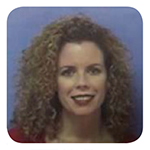 Ms. Caroline Lazzaruolo, who has served as the Undergraduate Medical Education administrator for the past five years, has now taken on the additional role of SOM Registrar effective May 1. Caroline has the right skill set and personality to do this job well.
Ms. Caroline Lazzaruolo, who has served as the Undergraduate Medical Education administrator for the past five years, has now taken on the additional role of SOM Registrar effective May 1. Caroline has the right skill set and personality to do this job well.
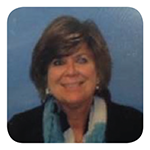 Ms. Dianne Tokar, who had worked as a part-time administrative assistant in the Office of Undergraduate Medical Education, is now our full-time Curriculum Support person effective May 1. Dianne will provide support to the Registrar and to those faculty members who need curriculum support to run their courses (especially interdepartmental courses) in Phase I and Phase III of the new LEARN curriculum.
Ms. Dianne Tokar, who had worked as a part-time administrative assistant in the Office of Undergraduate Medical Education, is now our full-time Curriculum Support person effective May 1. Dianne will provide support to the Registrar and to those faculty members who need curriculum support to run their courses (especially interdepartmental courses) in Phase I and Phase III of the new LEARN curriculum.
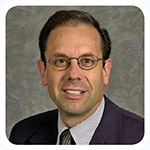
In August, 2014, the class of 2018 will be introduced to our revised curriculum, entitled the LEARN curriculum. The LEARN curriculum is the product of an initiative that began in the spring of 2011 with over one hundred faculty, students, and administrators at Stony Brook University School of Medicine working in specific subcommittees. Among our goals in introducing a reformed curriculum was our interest in increasing active learning, establishing early professional identity, and developing physician competencies in an integrated and contextual approach. The guiding principles for LEARN approved included a focus on active student learning, on students having responsibility to learn with faculty serving as facilitators, interdisciplinary integration of curricular content and earlier introduction of the clinical clerkships. The LEARN curricular model was approved by the Curriculum Committee in December 2013 after an eighteen month planning period.
LEARN is an acronym for Learning Centered, Experiential, Adaptive, Rigorous and Novel. The LEARN curriculum is divided into three Phases: an eighteen month foundational phase, a one year primary clinical phase and a sixteen month advanced clinical phase. Five themes will run throughout the three phases of the curriculum:
- patient and family-centered care,
- evidence-based care,
- patient safety and quality care,
- ethical and professional care, and
- health promotion and preventive care.
Several innovative features have been incorporated into the LEARN curriculum. These include transition courses at the beginning of each phase of the curriculum, Translational Pillars throughout the clinical phases of the curriculum, and the introduction of Stony Brook Teaching Families. The Transition courses provide training as students move from one phase to another. The Transition to Medical School at the start of phase one enables students to begin to understand the roles, responsibilities, expectations, and values of the medical profession. The Transition to Clinical Care course precedes the students entry into the clinical clerkships and enables students to learn their roles and responsibilities within the complex world of inter-professional care teams in in-patient and out-patient settings. The Transition to Residency is a course in the fourth year of the curriculum which prepares our students for the skills they will need to begin their internship following graduation. Another innovation in our LEARN curriculum is the implementation of Translational Pillars. Translational Pillars take place at defined intervals throughout the clinical phases. The educational goals of the Translational Pillars are to provide integration along the continuum of basic biomedical sciences to translational sciences to clinical sciences. The topics for the Translational Pillars will cut across all medical specialties and focus on current and emerging topics in the biomedical sciences that will have an impact in the clinical environment. Some examples of Translational Pillar topics include medical genetics, cancer biology, microbial pathogenesis, and metabolic diseases. The Stony Brook Teaching Families have been created by interdisciplinary teams of faculty to assist and enrich the curriculum. These families will visit the students throughout each phase of the curriculum.
Other components of the LEARN curriculum reflect recent and ongoing activities. During the most recent academic year, we instituted Longitudinal Learning Communities. These groups meet once a month in a social environment where faculty facilitators provide advice, guidance, and mentorship to students. In the LEARN curriculum, the Longitudinal Learning Communities will additionally serve as a venue for the development of peer assessment and feedback skills. Our Scholarly Concentrations Program is an optional activity in which many of our students participate. Five distinct tracks exist that span the interests of our students and their faculty mentors. These tracks include basic, clinical or translational research, global health, social sciences, medical humanities and ethics, and medical education. Students spend at least six months involved in their area of scholarly activity culminating with a presentation of their work through a poster session or oral presentations on Research Day in their fourth year.
Phase I of the LEARN curriculum begins in August of the first academic year and runs through February of the second academic year. It begins with the Transition to Medical School course followed by a new course, Biomedical Building Blocks, a six-month foundational course comprised of four components, The Body (anatomy), Molecular Foundations of Medicine (biochemistry, cellular biology and physiology), Pathogens and Host Defense (integrating immunology, inflammation, microbiology and immunologic diseases), and Basic Mechanisms of Disease (integrating histology, general pathology, hematologic and neoplastic diseases, and dermatologic diseases). The second part of Phase I includes several integrated organ systems physiology courses: cardiovascular, pulmonary and renal systems, gastrointestinal system, the endocrine and reproductive system, and a newly created course, Mind, Brain and Behavior which integrates fundamental neuroanatomy and neuroscience with neuropathology and psychiatric disorders. Physiology and Pharmacology are integrated throughout Phase I.
Three additional courses run throughout Phase one. Themes in Medical Education are week-long units that bridge key content across the curriculum. These week-long units will have a patient focus within an active learning environment. Two other courses also run longitudinally throughout Phase one. Introduction to Clinical Medicine introduces patient-based skills (history and physical exam) and Medicine in Contemporary Society introduces students to ethical and social issues in current health care.
Phase II of the LEARN curriculum is the primary clinical experience and runs for twelve months. This phase includes all of the clinical clerkships. The clerkships are periodically capped by the one-week Translational Pillars.
Phase III is an advanced clinical phase that runs sixteen months. Included in Phase III are sub-internships, clinical electives, the Transition to Residency course, and a specialized Advance Clinical Experience in selected areas of medicine.
We believe that our new LEARN curriculum will provide an enriching and active environment for medical education that will train our medical students to become life-long learners with the knowledge, skills and attitudes to work effectively in complex inter-professional health care teams and activities.

Written days prior to match week:
It’s been a long time since the beginning of fourth year. Or…at least it sure feels like it. Like the rest of medical school it seemed to go by in such a flash…or by the seat of my pants…or by some other motto that embodies an intense combination of stress, pressure, and panic. Reflecting months later, this proverbial “boogie-man” my mind generated wasn’t at all due to the difficulty of the time period, but rather the uncertainty. For the first time in my academic career, I understand that I have only minimal say as to where I’ll spend 6-8 years of my life. Also new is the realization that where I relocate doesn’t simply affect me. My fiancée will spend that time there…my first child will likely be born there…for the first time in my life getting it “wrong” could become catastrophic. So every decision has to, at bare minimum, be able to be rationalized as “good”.
But before we continue, it’s important to discuss what “good” actually means to an Orthopaedic surgery applicant. Good doesn’t mean perfect location. I don’t really pick what region I want – instead I pretty much apply everywhere I felt could be marginally livable and let the “gods” (aka program directors) decide where I’d “fit”. Good doesn’t mean good training. I’d be hard pressed to find a place where the training would actually be poor. “Good” = Matched. Period.
And so it goes, and my quest for a “good” outcome led me to away rotations. Selecting three places to spend a month at a time was as much an exercise in financial prudence as it was pandering to the wills and preferences of my fiancée and both our families. Close to home? Perfect, found a cheap room in a development bordering a nearby college town. Away from home? Yahtzee! - One of the Western Pennsylvania hospitals throws in free housing, a godsend to the significant cost the match process entails to a medical student. Fiancée’s preference towards NYC? Why not shoot the moon and try one of the time-honored programs in The City? In retrospect, I picked three great places to rotate. All were places where I’d be honored, privileged, and euphoric to be employed. More importantly though, I picked three places that each taught me what I wanted – and didn’t want – in a residency. I learned that I wanted a research hospital, and a place that would make me a good academic orthopod. I wanted a level one trauma center, where I’d be worked like a dog but trained like a rock star. Finally, I wanted a place to live where I could buy a house, my wife wouldn’t leave me, and I wouldn’t break the bank to make the bills every month.
The next stage of my quest for a good outcome was a parade that would put the Westminster Dog Show to shame: interview season. Looking back, what impressed me most about this was how similar, yet unique, every institution was during its interviews. They all wanted to know “why?”, “how?”, and who?”, yet their approach was very much their own. Some interviews were very formal, semi-structured conversations based on generic ice breakers. Others were unstructured and open, where a relaxed chat about sports was the only thing on the menu. A few provided hands-on activities that were purely to make sure you were – to paraphrase one of my mentor’s best – “not evil”. The stories of these activities are perhaps as famous as the programs that requested them. I look back fondly on a reverse-threaded putter, Buzz Light-year “Operation”, and drawing pictures. I even heard about one place that made you carve a talus out of a bar of soap…but part of me sincerely hopes no one seriously scored that (get it? No scrimshaw fans here? Sigh, but I digress). Lucky I didn’t interview there. I’d probably eat the soap or carve a bunch of notches in it and say it was a post-ankle fusion talus.
Looking back though, perhaps most memorable from the interview experience was the chance to meet so many different people all hopeful to become part of such an incredible field. Every background, culture, interest, and personality was represented. The most fun was making it to each place and quickly finding a familiar face on the trail. I still keep in touch with a lot of them, and can’t wait to get to know them more as colleagues in the future.
And so here I am now. Rank list composed and in, calculated with a highly scientific formula that involved gut feelings, hearsay from other orthopedic surgeons, and last minute scrolling through Zillow to make sure I could find a reasonable place to live. And I sit. And wait. I wait for an algorithm that by now has already calculated and re-calculated my fate. I have wishes, hopes, prayers….yes they prefer some places, but most are for “a” place. Because as an “ortho” applicant, my happiest day won’t be match day. It will be at 12 noon the Monday before, when if I’m a lucky man I’ll get a little ‘ding’ with some good news in my e-mail inbox. That ding, put bluntly, is the rest of my life. It’s of a great job, financial stability, a supported and comfortable family, and an opportunity to smile every day at work. They say it’s easy to find faith in the simplest moments. I nervously await my salvation.
Clinical and Educational Scholars (ACES)
It is with great pleasure that I introduce to the School of Medicine community the inaugural Academy of Clinical and Educational Scholars (ACES). ACES is a community of dedicated and scholarly medical educators whose creativity, energy and innovation will address important issues in medical education for the physicians of tomorrow. ACES’ mission is to develop and promote expertise in medical teaching, educational scholarship, and leadership among the School of Medicine faculty. Please join me in congratulating the following SOM faculty who were selected as founding members of ACES:
Janet Fischel, MD, Department of Pediatrics
Miguel Garcia-Diaz, PhD., Department of Pharmacology
Iris Granek, MD, Professor, Department of Preventive Medicine
Jonathan Mintzer, MD, Department of Pediatrics
Stephen Post, PhD, Department of Preventive Medicine
Paul Richman, MD, Department of Medicine
Lisa Strano-Paul, MD, Department of Medicine
Jennie Williams, PhD, Department of Preventive Medicine
Also join me in congratulating the following SOM staff who have been selected to serve on the ACES Steering Committee:
Dean, School of Medicine
Latha Chandran, MD, MPH, ACES Director, Vice Dean, Undergraduate Medical Education
Frederick Schiavone, MD, Vice Dean, Graduate Medical Education
Meenakshi Singh, MD, Vice Dean, Faculty Affairs and Faculty Development
Wei-Hsin Lu, PhD, Senior Education Specialist, Undergraduate Medical Education
Richard Iuli, PhD, Medical Education Specialist, Undergraduate Medical Education
The selection of these individuals for the inaugural Academy of Clinical and Educational Scholars reflects their contributions to teaching, mentoring, curriculum development, leadership and educational scholarship in medical education at Stony Brook University School of Medicine.
 |
| Paula Askalsky, Andrew Chen and Jadry Gruen (dancers), Jeremiah Joyce (narrator), four first year students performing an original piece – The Continuum of Learning.. |
The School of Medicine’s annual Evening of the Arts took place this year on Friday, April 4th, at 7:30 PM in Lecture Hall 1, which was transformed from a lecture hall into a genuine performance stage thanks to the efforts of many student volunteers. The annual talent show is, without a doubt, the SOM event (other than Match Day!) that students and faculty look forward to the most each year. Evening of the Arts is a time for students, faculty and staff to share their non-medical talents and gifts with their colleagues and peers. The event is normally loaded with incredible displays of talent ranging from musical performances to poetry, and this year’s show was no exception.
The evening opened, as is customary, with a video scripted this year by Rajapillai Pillai (a current second-year MSTP student), and produced by Nanavati-DeMatteo Productions (two current first-year medical students). The film was a rendition of Law and Order – Stony Brook SOM style! Following the video, which was a huge hit, EOA emcees Rajapillai Pillai, Rhia Shah and Erik Lepkowsky introduced a wonderfully impressive two and a half hour display of incredible talents.
 |
| Janet Kwok and Errol Reid Jr. – two graduating fourth year students walking off stage after beautifully performing an astounding compilation of songs. |
The evening’s performances, which included bands, dance troupes, solo and duo musicians, and poets blew the audience out of the water. It was truly a great show. Following the stage performances, an incredible exhibition of student art, which included paintings and photographs, was held in the Galleria. The event was catered by every medical student’s favorite restaurant — O Sole Mio. While the food was in short supply, wonderful conversations, hearty laughs, and loving embraces were in abundance and shared by all.
Evening of the Arts, which always holds a special place in the hearts of many medical students, is also an important milestone in the lives of all fourth year medical students as it marks, in many ways, the end of an era for them. Following on the heels of Match Day, it is another signal that their medical school careers are coming to an end. As expected, emotions were high, and the event as a whole was bittersweet for the fourth-year students. Not surprisingly, this year’s performances by fourth-year medical students left the entire audience wanting more!
All who attended Evening of the Arts, performers and non-performers, had a great time and, as always, exemplified the fact that not only are Stony Brook and Winthrop medical students and faculty exceptional physicians-in-training and physicians, but also they are extremely talented performing and visual artists who are members of the rich culture which defines the world around us. If you were unable to attend this year’s event, not to worry! As mentioned above, this is annual, so look out for future announcements for Evening of the Arts, 2015!
PHOTOGRAPHY BY AMY FULLER

First year medical students were brought together on January 17, 2014, for a day - long retreat to learn about bioethics, disparities in healthcare, patient advocacy and the life of Henrietta Lacks. Prior to the event, each student received a copy of The Immortal Life of Henrietta Lacks, a New York Times best-seller, about a woman with cervical cancer in 1951. Her cells – now known worldwide as HeLa cells – became vital to a medical revolution for vaccines, gene mapping and laboratory research. The book served as a springboard to workshops on important issues in science, society, and ethics.
Dr. Iris Granek organized the event by bringing many medical school faculty together from multiple medical disciplines. These faculty provided a wide range of workshops to the day sparked by the many themes covered in the book. Dr. Aldustus Jordan, Associate Dean for Student Affairs at Stony Brook University School of Medicine, a workshop participant, commented that “this educational program brought students together to foster conversation, positive interaction and teamwork to answer difficult questions and consider different perspectives to concepts in medicine and society.”
Jump-starting the day was an adaptation of the book with a performance by first year medical students, Opeyemi Ajibade, Marc Delaney, Sarah Justvig, and Cindy Ocran. The Readers Theatre presentation, written and directed by Professor Lauren Kaushansky brought to life the characters of Rebecca Skloot (the author), Henrietta Lacks (the patient), Deborah Lacks (Henrietta’s daughter) and Doctor George Gey (from Johns Hopkins Hospital who harvested her cells for research).
In the Readers’ Theatre piece Doctor George Gey represents those who see beauty, challenge and knowledge as he commits his life to find answers to unsolved problems of medicine. Science is his passion. “Science! Understand this and you understand everything!” Rebecca Skloot is the writer looking for the “truth, the story, the woman” behind the cells. She spent ten years researching and ultimately gaining the trust of the family whose history was one of great mistrust for both the medical profession and writing community. In the play she uses “words to organize thoughts.” Ultimately, questions posed by Deborah Lacks’ (daughter of Henrietta) become “her questions” as Skloot begins to immerse herself in the dreams, pains, and quest of the family’s need to know what happened to their mother and her cells.
Deborah Lacks, the daughter of Henrietta Lacks, is tormented by both her mother’s absence in her life (Henrietta died at the age of 31 of cervical cancer) and presence in the world (knowing her cells are “everywhere.”) “These cells, they follow me everywhere I go and best I can tell, they’re probably following you, too!” She represents the part of the population who doesn’t understand the medical jargon, as well as frequently doesn’t have enough money for her own health care. She is bold and unpredictable, and frequently challenges the medical community:
“Oh, I see. You mean, it’s far too complicated for ME? Meaning, you don’t think I can understand? I got me a dictionary! I got me a reporter! I got mama’s medical records! I read the Bible. I believe in education. So…educate me! Or is that too complicated for you?”
Henrietta Lacks, the African American woman who died of cervical cancer in 1951 represents the patient, mother, and friend, whose life was cut short, but has come back to us through this book, to remind us, that these cells came from a real person. She is a dreamer: “All I’m saying is: the present don’t need to be the same as the past. Ya hear me? A person can dream. A person can change things. Me and my cells, we know that’s the truth!”
“This performance is designed to be visual, dynamic and provocative,” said Lauren Kaushansky, Lecturer, Professional Education Program in Stony Brook’s Department of History, and the playwright and director of the adaptation. “We asked the students to take the scientific, social and ethical issues brought forth in Ms. Lacks’ story and apply them to the workshops and ask themselves, ‘What is different today?’”
For example, during the workshop “How Have HeLa Cells Changed Our Lives” led by Jennie Williams, PhD, Associate Professor of Preventive Medicine and member of Department of Medicine’s Division of Cancer Prevention, the students learned about the vast contributions of HeLa cells to science, including new applications such as in vitro cancer studies. “The students also acquired an appreciation of the moral dilemma associated with the initial use of Ms. Lacks’ cells and the opportunities it afforded in the pursuit of scientific endeavors,” said Dr. Williams.
At the close of the program, the students were challenged to develop a sequel to the Readers Theatre play and participated in a performance in which they provided answers to the question, ‘What is different today?’ In voices depicting the next generation of scientists, doctors, and patients, they provided declarations on stage imagining ways to improve healthcare, bioethical practices, and patient advocacy.
*Many quotes from the Readers Theatre play based on “The Immortal Life of Henrietta Lacks” and adapted by Lauren Kaushansky.
When I originally met with Lauren Kaushansky from the Professional Education Program in Stony Brook’s Department of History to discuss a HELA Day event for the first year medical students, the goal was to create an innovative and engaging learning experience. We utilized the book The Immortal Life of Henrietta Lacks as a springboard for focusing on past and present ethical issues in medicine and research. We planned opening with Lauren’s Reader’s Theatre play, followed by a series of workshops and discussions, a closing activity, and a follow up written reflection. As the decision to hold the daylong event occurred after posting of the academic calendar, selecting a date required rescheduling time from the neuroscience course and including the first year dental students.
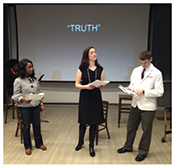 As such, Dolores Cannella, Assistant Professor of Dental Medicine joined the planning sessions. We agreed that for the HELA Day activities, 3 to 4 dental students would be assigned to each of the 12 established medical student teams. Unlike other classes in which the dental students formed separate small groups, it was gratifying to observe the warm welcome the medical students extended to the dental students and the way in which they all collaborated on the tasks. In fact, the final event of the day involved the team members working together to come up with powerful statements inspired by the issues raised during the day and delivered by selected team members during the closing “Reader’s Theatre Remix”. As one student wrote in their evaluation of HELA day, “…I LOVED the presentation at the end. It built such a sense of community around a topic that is so important to consider as future physician/researchers.”
As such, Dolores Cannella, Assistant Professor of Dental Medicine joined the planning sessions. We agreed that for the HELA Day activities, 3 to 4 dental students would be assigned to each of the 12 established medical student teams. Unlike other classes in which the dental students formed separate small groups, it was gratifying to observe the warm welcome the medical students extended to the dental students and the way in which they all collaborated on the tasks. In fact, the final event of the day involved the team members working together to come up with powerful statements inspired by the issues raised during the day and delivered by selected team members during the closing “Reader’s Theatre Remix”. As one student wrote in their evaluation of HELA day, “…I LOVED the presentation at the end. It built such a sense of community around a topic that is so important to consider as future physician/researchers.”
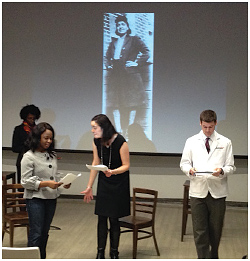 Reading those comments, I realize identification with community was enhanced by participants taking part in the activities as well as the sense of being part of something special. This sentiment is echoed by the following quotes from first year medical student Sarah Justvig who portrayed Rebecca Skloot in the Reader’s Theatre. “As members of this health care community, we are privileged to be a part of an institution that places great emphasis on ethics and the discussions that flow from the study of such issues, thereby preparing us to confidently inform future policy and arrive at ethical decisions for our patients. The HELA Day experience provided me with yet another reason to be grateful for my rich Stony Brook medical education.”
Reading those comments, I realize identification with community was enhanced by participants taking part in the activities as well as the sense of being part of something special. This sentiment is echoed by the following quotes from first year medical student Sarah Justvig who portrayed Rebecca Skloot in the Reader’s Theatre. “As members of this health care community, we are privileged to be a part of an institution that places great emphasis on ethics and the discussions that flow from the study of such issues, thereby preparing us to confidently inform future policy and arrive at ethical decisions for our patients. The HELA Day experience provided me with yet another reason to be grateful for my rich Stony Brook medical education.”
Upon further reflection, I recognize that the HELA Day experience actually impacted many more members of the Stony Brook Medicine community than the 41 dental and 125 medical student participants. This included those directly involved in coordinating and providing the event from the School of Medicine: 9 multi-disciplinary/multi-departmental faculty, 5 multi-departmental staff and 2 Deans along with 2 faculty from the School of Dental Medicine. In addition, by utilizing the 24 second year medical student Teaching Assistants to provide written feedback to the first year medical students on their final reflections on the day, the discussions spread to incorporate the perspectives from another group of students in our community. Comments from one of the TAs, MS2 student Damilola Oladeru included, “Overall, the event left a positive impression on the students and left them with questions to reflect on. On a personal note, I believe it’s a unique and successful way to teach medical students about ethics and disparities.” In conclusion, it seems that the HELA Day event successfully accomplished both the initial goal of providing an engaging active learning experience, as well as the unanticipated outcome of strengthening a sense of community. To support this, I will end with the following anonymous CBASE comments from one of the first year medical students, “Overall, I thought HeLa day was a success. I had an awesome discussion with some classmates at lunch about HeLa and laws governing human subjects research, which I would have never had on a regular school day.

This year’s Diaspora of Color Program can be described with three words: colorful, inspiring and energetic. Our host, Raja Pillai, kicked off the program by inviting Ms. Jaylene Clark to render original and thought-provoking poetry pieces. Ms. Clark’s memorable verses describing her “Brooklyn” hometown, and how it has retained her beauty and tradition despite economic and social changes to the borough. She also reminded us of how inspiring Student National Medical Association (SNMA) is to other young students in the community. Her words were followed by Arjun Dhawan’s (Class of 2016) beautiful tribute to his hero, Nelson Mandela. The audience was reminded of Mandela’s suffering, dedication to humanity and legacy. Following a brief intermission featuring Nigerian cuisine, the acappella group the Lymph Notes rocked the house with “Gede Nibo.” The Lymph Notes were followed by a play “Anansi and the Yam Hills,” directed by our host, Raja.
Guest speaker Dr. Tracie Saunders graced us with reflections from her experiences as an anesthesiologist, ordained minister and author. She shared reflections from her recent medical mission in Kitwe, Zambia where she rendered skills that allowed women to see and hold their babies following delivery. Dr. Saunders reminded us of the importance of finding balance in our lives as future health care professionals and staying true to our virtues and passion. The celebration ended with a performance by Boussou African Dance Drum Ensemble. The dance troupe energized the audience with music from Senegal, Mali, Gambia and Ghana, and dance by children and adult artists. They taught the audience (including faculty!) to let loose and live in the moment by inviting us to dance with them till we were tired. Special thanks to the 2013-2014 SNMA E-board, student performers, guest speaker, artists, faculty and staff for their support of this event. Proceeds from the event were delivered to the Hispanic Counseling Center in Hempstead, New York.
This year’s AOA/GHHS induction dinner was held on Tuesday, April 29 at the Old Field Club. This annual event was hosted by Dr. Kenneth Kaushansky and Dr. Jack Fuhrer, and the guest speaker for the evening was Dr. Mark L. Zeidel, M.D., who is the Herrman L. Blumgart Professor of Medicine at Harvard Medical School and Chair of the Department of Medicine at Beth Israel Deaconess Medical Center in Boston. A big congratulations to all our inductees!
| AOA Honor Medical Society | |
Alexander Abramowicz * Jr. AOA inductees | James Gardner Morgane Giordano* Lauren Goldberg * Abdul Kouanda Daniel Migliaccio Brandon Napstad Andrew Smith* Clifford Sung Cameron Sweeney * Emily Taub Ajayram Ullal Daniel Ventarola* Caitlin Welch Michael Yee * |
| Gold Foundation Humanism Honor Society | |
| Raymond Beyda Hannah Biederman Muath Bishawi Kathryn Bradford Jared Cassin Crista Cerrone Laura Chen Janice Cheong Deirdre Connolly Anne Darves-Bornoz | Michelle Dumond Michael Gavalas Janet Kwok Roger Luo Alyssa Nastro Lindsay Rothenberg Danielle Sganga Clifford Sung Cameron Sweeney Carrie Wong |
| Download PDF Version |


